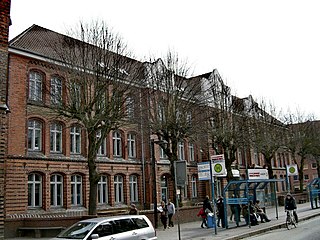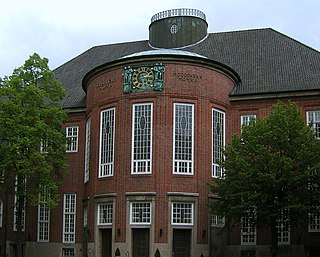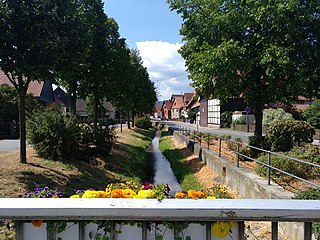
Goslar is a historic town in Lower Saxony, Germany. It is the administrative centre of the district of Goslar and is located on the northwestern slopes of the Harz mountain range. The Old Town of Goslar with over 1.500 timber houses and the Mines of Rammelsberg are UNESCO World Heritage Sites for their millennium-long testimony to the history of ore mining and their political importance for the Holy Roman Empire and Hanseatic League. Each year Goslar awards the Kaiserring to an international artist, called the "Nobel Prize" of the art world.

Education in Germany is primarily the responsibility of individual German states, with the federal government only playing a minor role.

Goethe-Gymnasium is a gymnasium named after notable Frankfurt native Johann Wolfgang von Goethe (1749–1832). It is situated in the Westend of the city of Frankfurt am Main in Germany, near the Hauptbahnhof.

The Katharineum zu Lübeck is a humanistic gymnasium founded 1531 in the Hanseatic city Lübeck, Germany. In 2006 the 475th anniversary of this Latin school was celebrated with several events. The school uses the buildings of a former Franciscan monastery next to Saint Catherine Church, which was extended in the 1880s.

The Harzburg, also called Große Harzburg, is a former imperial castle, situated on the northwestern edge of the Harz mountain range overlooking the spa resort of Bad Harzburg in Goslar District in the state of Lower Saxony, Germany. It was erected from 1065 to 1068 at the behest of King Henry IV of Germany, slighted during the Saxon Rebellion in 1073-75, and a century later rebuilt under Emperor Frederick Barbarossa and his Welf successor Otto IV, who died here in 1218.

Georg Wilhelm von Siemens was a German telecommunications industrialist of the Siemens family.

Gymnasium Achern is a Gymnasium in Achern, Baden-Württemberg, Germany, founded in 1877. Its address is Berlinerstraße 30. It has about 1000 students and 95 teachers. The current principal is Fabian Sauter Servaes. It emphasizes science, foreign languages, and art. It was one of the first gymnasiums in Baden-Württemberg to graduate its students after eight years instead of the usual nine years, before this was made compulsory for all gymnasiums in the state.

The Friedrich-Ebert-Gymnasium (FEG) is a German high school in the Harburg borough of Hamburg, Germany, that is known to exist since 1628. The school is famous for its Friedrich-Ebert-Halle, where the Beatles had their first professional recording session, backing Tony Sheridan in 1961.
The Humboldtschule is one of two Gymnasiums, besides the Kaiserin-Friedrich-Gymnasium (KFG), in Bad Homburg vor der Höhe, Hesse, Germany.

The Gelehrtenschule des Johanneums is a Gymnasium, or grammar school, in Hamburg, Germany. It is Hamburg's oldest school and was founded in 1529 by Johannes Bugenhagen. The school's focus is on the teaching of Latin and Ancient Greek. It is proud of having educated some of Germany's political leaders and some of Germany's notable scientists. The school is operated and financed by the city of Hamburg.

Johann-Wolfgang-von-Goethe-Gymnasium Chemnitz is a public secondary school in Chemnitz, Saxony, Germany, for grades 5–12. It is one of seven secondary schools operating in Chemnitz, Bernsdorf

Eberhard-Ludwigs-Gymnasium is a gymnasium in Stuttgart established in 1686. The gymnasium is the oldest in the city, from which many of the others emerged over the years. It is often referred to as ‘Ebelu’, made up of the first few letters of the namesakes names.
Hans-Dietrich-Genscher-Gymnasium Halle is a secondary school (gymnasium) in Germany. It was established in November 1908. Currently, about 600 children attend the school. The school is situated right in the city center of Halle an der Saale and is widely known for its two educational profiles: German secondary school and bilingual English-German profile. In 2009 the school celebrated its 100th anniversary. The school is named after Hans-Dietrich Genscher, a German politician.

Harlingerode is a village in Germany and district of Bad Harzburg in the district of Goslar in Lower Saxony. As of 2020, Harlingerode had a population of 2,916.

The Siemens family is the name of a German noble family, family of technology and telecommunications industrialists, whose members were founders and to the present day the largest shareholders of Siemens AG. The family have a wealth of over €8 billion, making them the 5th richest family in Germany, according to Handelsblatt.

The Kardinal-Frings-Gymnasium is a private catholic secondary school of the Roman Catholic Archdiocese of Cologne in Beuel, a borough of the former German capital Bonn in North Rhine-Westphalia.

Bettingerode is a village that forms a municipal district of Bad Harzburg in the district of Goslar in Lower Saxony. As of 2020, Bettingerode had a population of 402.

The Feodor-Lynen-Gymnasium Planegg is a government secondary school in Planegg in the German state of Bavaria. It belongs to the mathematical-scientific category of gymnasia but also has an economic educational branch. In 2022–23, 992 pupils attended the FLG, with a staff of approximately 74.

The Artland-Gymnasium Quakenbrück (AGQ) is a secondary school in the Artland region for students in grades 5 to 13. The Gymnasium dates back to a Latin school first mentioned in 1354, making it one of the oldest schools in Lower Saxony.


















